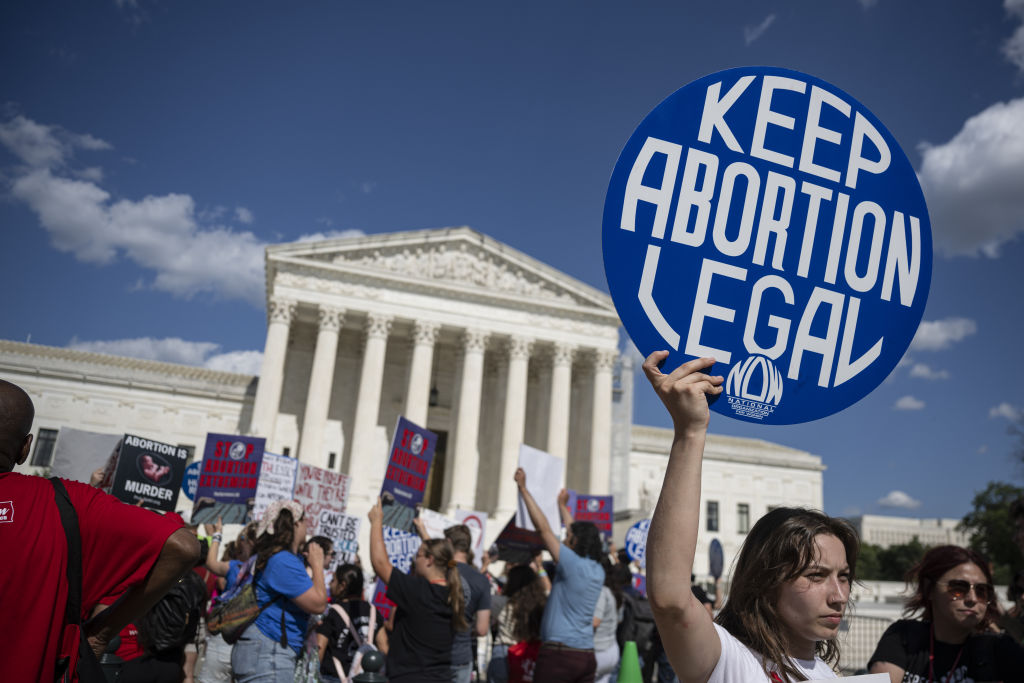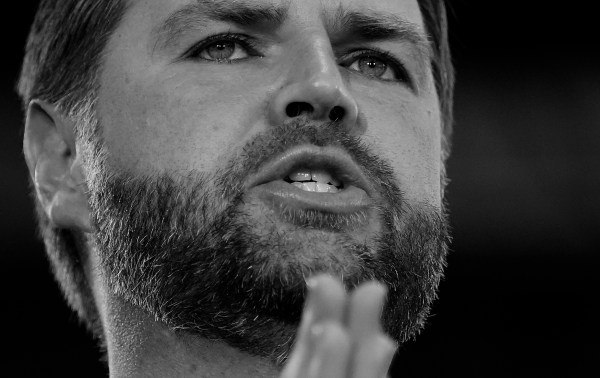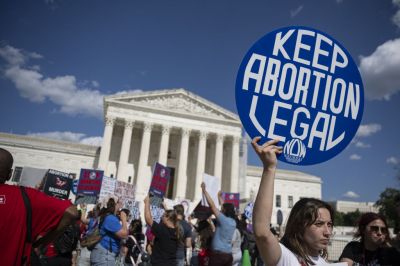In keeping with the Democratic nominee’s preferred political strategy, the party's recently concluded convention was relatively heavy on the vibes and light on policy—with one glaring exception.
“Reproductive freedom” was given a stark spotlight, and Vice President Kamala Harris used her acceptance speech to call Republicans “out of their minds” for seeking to pass pro-life legislation. By Friday, even former President Donald Trump was posting that, “My Administration will be great for women and their reproductive rights.” It’s a far cry from 2008, when Hillary Clinton would repeat her husband’s successful approach, saying abortion should be “safe, legal and rare,” occasionally adding, “and by rare, I mean rare.” How did we get here? And how did we get here so quickly?
For those of us who consider ourselves pro-life, the Dobbs decision that overturned Roe v. Wade was the culmination of 49 years of long, deliberate, and, to my mind, heroic efforts to remake the composition of the Supreme Court. Millions of Americans voted, donated, organized, and acted to see justices of an originalist bent appointed. Yet, for many on the left (and the apolitical center), the decision seemed to come out of nowhere. As the New York Times’ Elizabeth Dias and Lisa Lerer illustrate in their book The Fall of Roe: The Rise of a New America, many on the left never expected the right to actually mean what they said.
Wendy Davis, the one-time Texas gubernatorial candidate and state senator who went viral for her late-night filibuster in pink sneakers, tells the authors that she “always thought the Supreme Court was going to save us.” Cecile Richards, former president of the Planned Parenthood Federation of America, says she held out hope someone within the Republican Party would ultimately say, “Look, I understand [overturning Roe] has been our strategy for all these years, but, in fact, that’s going too far.”
Roe’s demise was the product of decades of activism, prayer, and strategy. Other works have traced how the movement was founded, funded, and formed, but Dias and Lerer pick up their story around the time of the famous GOP “autopsy” in 2012. They show how the Republican Party’s identity crisis threatened the pro-life movement, but also how it spurred a more aggressive strategy from those ready to move beyond incremental approaches.
Two Times reporters might be expected to get access to progressive leaders like Richards and Davis. But what makes their book especially compelling is the work they put in to cultivate relationships with decision-makers on both sides of the issue. Figures who will deservedly go down in the conservative pantheon for their role in helping seal Roe’s fate—like Susan B. Anthony Pro-Life America (SBA) President Marjorie Dannenfelser, former Federalist Society Vice President Leonard Leo, and Mississippi Attorney General Lynn Fitch—get their well-deserved close-up. Reputationally, they will go down as Goliaths, but on the field of the battle, they had collectively played the role of David.
Social conservatives fought against not just a mainstream establishment that saw Roe as a kind of “super-precedent,” but against an institutional Republican Party that welcomed their votes while continuously deprioritizing their issues. At one point, Dias and Lerer recount, the SBA operating budget was less than 2 percent that of their political nemesis, Planned Parenthood.
And yet, through fate or God’s providence, a series of high-stakes gambles paid off: the decision to hold open the Supreme Court seat left vacant by the death of Justice Antonin Scalia, striking a “deal” with then-candidate Donald Trump and sticking with him in the aftermath of the Access Hollywood tape. The result was the confirmation of Justice Neil Gorsuch and then Justice Brett Kavanaugh, as well as leaning on red state legislators to pass increasingly aggressive laws that winnowed away Roe’s protections of abortion.
And then the last, significant twist in September 2020—the passing of Justice Ruth Bader Ginsburg and the nomination of Notre Dame law professor Amy Coney Barrett to replace her. In the span of one presidential term, three rock-solid Supreme Court justices added to the two existing conservative stalwarts. It’s no wonder, as Dias and Lerer opine, that “positions once relegated to the fringes of American political life—overturning an election or overturning Roe—suddenly seemed possible.”
They bring us inside the conference room where pro-life activists huddle to discuss their strategy given the new makeup of the court. Should the litigants stick to the plan of defending Mississippi’s new 15-week ban in hopes of getting the court to chip away at Roe without formally undermining it (a position that, according to later leaks, Chief Justice John Roberts was drawn toward)? Or should they, to use the common vernacular, go big or go home?
Scott G. Stewart, the solicitor general of Mississippi, opted for the latter route, urging the court to decide as it ultimately did—that Roe and its 1992 successor, Planned Parenthood v. Casey were, in the words of Stewart’s legal brief, “egregiously wrong.” That tack, Dias and Lerer write, was a lesson Stewart learned from his old boss, Justice Clarence Thomas: “Stick with a position, take the heat, and never budge.” The move paid off.
Dias and Lerer’s book wraps before the most recent string of pro-life losses at the ballot box and the looming sense that the Republican Party, led by former President Donald Trump, is ready to move on from the issue. Their deep reporting suggests a fascinating alternate history: What if Justice Ginsburg had hung on for a few more months? What if the chief justice had been able to persuade one of his new colleagues that a modest chipping away at Roe was preferable to overturning it entirely?
In either of those cases, the political backlash to Dobbs itself would have almost certainly been less severe, with social conservatives continuing to find creative legal means to smother legal abortion. A backdoor ban on abortion, relying on enforcement by private citizens and targeted regulation of abortion clinics, might have tightened the screws on the Roe regime without engendering so much backlash.
It’s possible waiting to topple Roe until a later case would have given the pro-life movement more time to ready the political barricades. But there’s also the chance that opportunity might have never come. And while more preparation for the aftermath would have been welcome, the upshot of Dias and Lerer’s reporting is that many in the Democratic Party, the abortion industry, and America at large never thought Roe was going anywhere. As they summarize, “most Americans didn't realize [abortion rights] were at risk. That disconnect had created a believability gap” between the fervent pro-lifers and the voters who would go on to decisively vote to erase state abortion restrictions from California to Michigan to Ohio to Vermont.
While Dias and Lerer focus on the political and legal work that went into Roe’s demise, Shefali Luthra, a reporter for The 19th—a news website focused on gender and politics—offers an intimate and vivid look into why the Dobbs decision hit so many so hard. Undue Burden: Life and Death Decisions in Post-Roe America does not strive for the even-handedness of The Fall of Roe, but it is a work of advocacy, detailing the chaos the sudden overturning of Roe caused for pregnant women and abortion providers.
Undue Burden takes for granted progressive stances on the necessity and morality of legalized abortion. Pro-life viewpoints in the book are limited to protesters outside clinics, without engaging with the moral and philosophical arguments they might advance for why access to abortion should be restricted. Yet Luthra performs a valuable work of empathetic journalism, a powerful reminder of the challenges that face those for whom a new arrival threatens to upset the delicate balance of their lives to date.
Luthra vividly puts the reader alongside the women for whom abortion feels like the only option—and the lengths to which they are willing to go to procure one, even in a post-Roe America. Yet despite the sympathetic pro-choice slant of the book, those who are engaged with the pro-life movement would find it worth reading.
The challenges these women face—from severe health complications to economic precarity to their perceived inability to care for another child—leave these women feeling like abortion is the solution. One mom who ends up giving birth, having been unable to procure an abortion, tells Luthra that, “As much as I love this baby, I would wish this on absolutely no one. … I still ideally would have had that abortion.”
These are difficult challenges that no amount of free diapers or baby formula can address. Building an authentic culture of life requires massive social, political, and cultural change.
The women Luthra profiles can’t believe there are so many policy-created hurdles, and so much stigma, around a procedure they view as necessary health care. “It actually seems really ridiculous, right?” one woman says. “There seems to be a different set of rules when it comes to sexual and reproductive health care.”
Well, yes, there is, for the simple fact that pro-lifers believe that the choice isn’t just about what a woman does to her body, but to the still-forming body she carries within her. Luthra’s book even gestures to the humanity of the fetus, following a mom who chooses a late-term abortion because of detected abnormalities. She flies to D.C., opting for an injection to stop her unborn son’s beating heart before the abortion takes place. When she returns home, Luthra writes, “the tears she cried were real.” Any pro-lifer would mourn the loss of her son with her; and most of them would agree that procedures that intentionally stop the heart of a late-term fetus should not be allowed, whatever the rationale.
In 1973, Roe short-circuited the political process, abruptly imposing abortion through the first two trimesters on a nation that had only recently begun to liberalize it. The long-run ramifications of that decision poisoned our politics and shaped our culture for the next half century. Whatever the future holds for the pro-life cause—and I am on record as believing the stakes are quite dire—the overturning of Roe was an epochal moment in the history of the conservative movement and American history writ large. Each in their own way, these two books shed light on how we got to a post-Roe America, and the challenges that reality will pose to those who earnestly believe in both supporting moms and protecting unborn life.







Please note that we at The Dispatch hold ourselves, our work, and our commenters to a higher standard than other places on the internet. We welcome comments that foster genuine debate or discussion—including comments critical of us or our work—but responses that include ad hominem attacks on fellow Dispatch members or are intended to stoke fear and anger may be moderated.
With your membership, you only have the ability to comment on The Morning Dispatch articles. Consider upgrading to join the conversation everywhere.